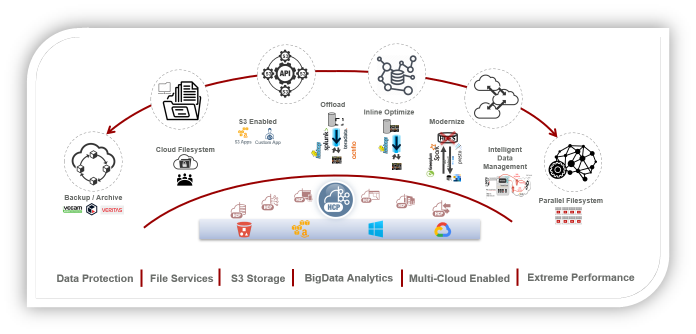Revolutionizing Object Storage to Meet Rising Hybrid Multi-Cloud Demands


With the advent of cloud services, IT is transforming and evolving from being traditionally data center-centric to data-centric. The data center is no longer a physical location. It extends beyond the walls of the enterprise, to the cloud, and the edge where the majority of data is being generated.

Enterprises today are embracing the value of leveraging services from multiple cloud providers as part of a hybrid and multi-cloud strategy. This vision and state of operation to move applications and data to public-cloud platforms comes with a set of challenges from technology, operational management, security, and financial issues. It also involves adopting new operating models and architectures from Software-as-a-Service (SaaS) to Platform-as-a-Service (PaaS), on-premises to cloud, and from containers to Kubernetes. Not to mention, the set of high-value legacy applications that are critical to the business that are posing obstacles to the cloud strategy.
Managing and protecting your business’ data is a critical component of your IT strategy. People need to create and access data across all of their devices as well as in the cloud to become more productive. Meanwhile, there is a strong focus on data management efficiencies and cost optimization. Wherever data is stored, customers expect that it is uniformly secure.

Hitachi Vantara realizes that the path to a true multi-cloud environment and strategy begins by building a highly available, performant, and scalable cloud platform. Hitachi Content Platform (HCP) is a mature object store that is designed to provide an on-premises cloud storage experience for protecting and scaling unstructured data. Its hallmarks are ease of use, efficiency, and massive scalability. HCP has a healthy ecosystem of independent software vendors (ISVs) and products/tools to augment and complement customer architectures and use cases. The product compatibility guideopens in a new tab provides a complete list of certified independent ISVs with version and interface compatibility for each supported application.
Most of our customers have multiple environments and are evaluating modernization and cloud. Such environments span a multitude of use cases that Hitachi Vantara classifies as the different types shown in the featured post image. Their journey starts with the more traditional data protection use case on the far left. At this stage, customers are generally focused on their backup environment and recent adoption of an S3 cloud platform as the primary storage library providing more secure options like immutable backupsopens in a new tab using S3 object lock capabilities.
From there, the same customers begin to expand their use of an S3 cloud platform to file services, adopting cloud filesystems for workload sharing as an emerging use case. During this chapter, they begin to offer modern hybrid cloud capabilities and cost-effectively leverage their existing infrastructure investments. They take advantage of minimizing latency and overcoming the consequences of on-premises data gravity. The built-in Hybrid cloud capabilities enable them to deliver file services more efficiently to remote and branch offices, accelerating ingest performance for edge IoT devices and applications for better insight and data analysis.
To learn more about HCP and the most common questions we get from our customers around software-defined object storage, tune into “Software-Defined Infrastructure: Transform & Secure IoT & Big Data Environments”. In this webinar, DCIG Analysts, Todd Dorsey and Ken Clipperton, Hitachi Vantara Global CTO, Data intelligence, Jason Hardy, and Hitachi Vantara Director, Product Marketing Hitachi Content Portfolio, Tanya Loughlin review why HCP is named a leader in the DCIG Top 5 Software-defined Object Storage Report.opens in a new tab
The next chapter for customers is the acceptance and implementation of an S3 cloud protocol in the development of new applications as a reasonable first step to infrastructure neutrality. At this stage, these applications are more likely to benefit from Hybrid and Multi-Cloud services.
Our customers know that big data environments, such as Splunk and Hadoop/Cloudera continue to grow exponentially. Therefore, in parallel to the S3 application modernization stage, big data environments are feeling a lot of pressure from the advancement in S3 cloud platform services and modern integration options. These advances have proven to be highly effective in supporting existing workloads. These include Splunk SmartStore, Spark, and Presto, to name a few.
For big data environments, we offer our customers three important optimization solutions to satisfy the wide range of architectures for different customer deployments. Whether your current architecture is more suitable for a straightforward offload technique, inline optimization, or more innovative modern alternative, all three options offer varying degrees of Hybrid and Multi-cloud-ready deployment.
The last area we are investing in along this journey is twofold. The first leg is the transformation of Hitachi Cloud Platform into intelligent data management rather than an S3 storage target. This is where we offer modern hybrid cloud capabilities that allow users to straddle on-premises and cloud installations to create workflows that offer easy and efficient ways to operate on your data. Efficient data transformation is accomplished by creating the data on-premises and then leveraging cloud services like AWS transcoding. Cloud services operate on the data, transform it in the cloud and then return the outcomes of the processed data on-premises – where it is indexed and analyzed.
Watch the Truth in IT video, “Cloud Repatriation: As IT Priorities Change, Organizations Turn to Object Storage for Active Data,” where DCIG and Hitachi Vantara set out to answer questions like, “How is data analyzed across private, hybrid, and multi-cloud environments?“, “Can you set policies to move data between clouds?“, and “How are customers enriching existing data after analysis?”
The second leg addresses extreme performance use cases. Organizations in many industry sectors need to unlock the full potential of data using advanced analytics. For example, in financial services, real-time analytics are needed for fraud detection and risk management. As data continues to grow exponentially, datasets are scaling to extreme capacities; while needing to maintain the maximum performance demanded by data-intensive applications. This is a real challenge. It’s exemplified in financial services where 1 terabyte of data can be created during each trading session. This is why, Hitachi Vantara recently introduced a parallel filesystem supporting GPU direct storage and unified protocol access (POSIX, NFS, SMB, CSI, S3). It comes with a zero copy/zero tuning architecture supporting small and large files simultaneously. Moreover, the solution fully supports on-premises, Hybrid delivery models utilizing AWS, and Multi-Cloud deployment choices.
We recognize that you are on a cloud journey to solve a problem, reach a goal, or achieve an aspiration. Hitachi Vantara is ready to embark on this journey with you. Talk with one of our solution experts for more detail about each of these areas.
Dia Ali is Global Solution Lead, Digital Content, Hitachi Vantara.
Dia Ali is Global Solution Lead, Digital Content, Hitachi Vantara.